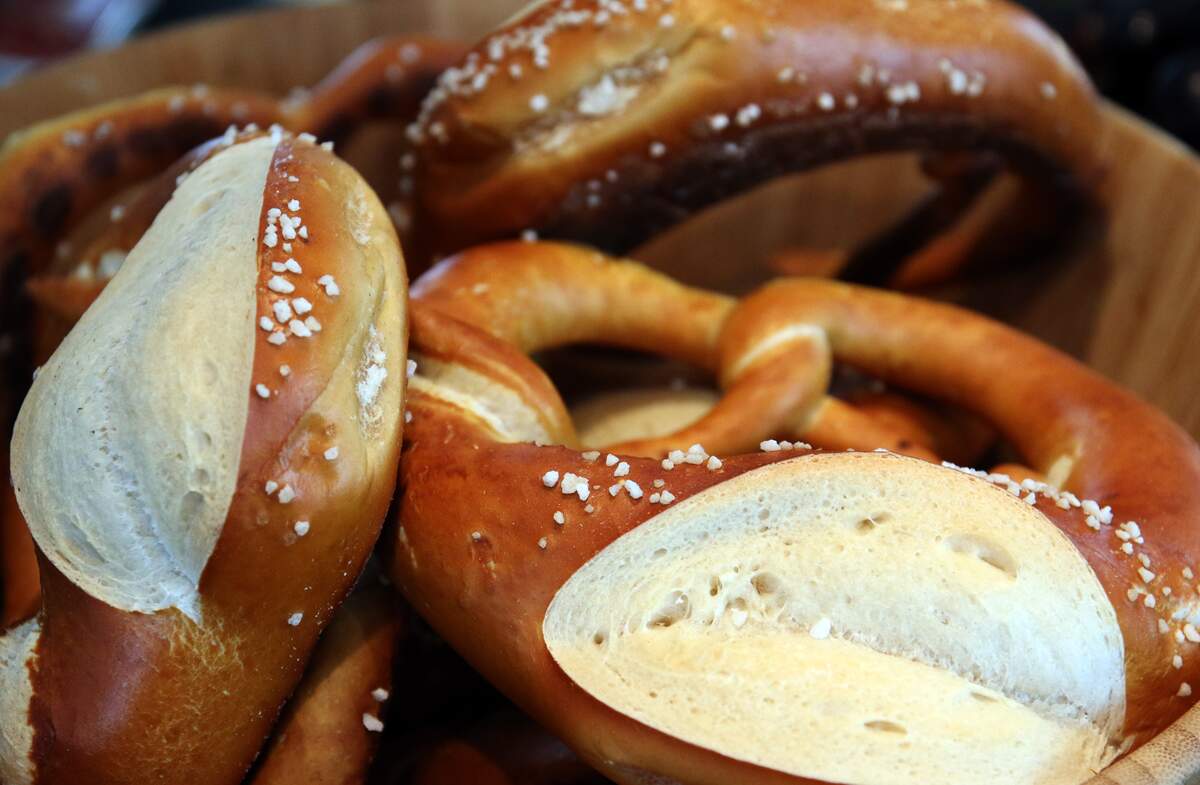

Eat a Pretzel Day
Soft or hard, twisted into a knot or straight, large or small, salted or plain, served with mustard or cheese—there are many types of pretzels and ways to eat them. And eat them we will—it is Eat a Pretzel Day, after all!
Pretzels may be the world's oldest snack. Legend has it that an Italian monk invented the soft variety in 610 CE when he rolled and baked thin strips of dough into the shape of children's arms folded in prayer, and gave them as a reward to children who learned their prayers. The monk called them pretiola, the Latin for "little reward," and parents of the children called them brachiola, meaning "little arms." When they made their way to Germany—one of the countries where they remain most popular today—they became known as bretzels.
It also was in the seventh century that the Catholic Church put in place strict rules related to fasting, which helped the popularity of pretzels grow. Being that the main components of pretzels are bread and water, they came to be seen as a penitent food that could replace more substantial meals. Likely on account of their religious connection, they became known as symbols of good luck. For example, children in Germany have traditionally worn them around their necks as good-luck charms on New Year's Day.
Pretzel baking remains popular in Germany, particularly in the region of Franconia and surrounding areas. Many varieties are made for same-day consumption, being sold in bakeries and in stands or booths on downtown streets. They are often sliced horizontally and buttered, which are known as "butterbrezel," or are served with slices of cold meat or cheese. German soft pretzels are made with assorted flours like rye, spelt, or whole wheat, and are topped with melted cheese, bacon bits, or sunflower, pumpkin, caraway, sesame, or poppy seeds. Many local varieties of pretzels are made throughout Germany. In Bavaria, they are often served alongside the main dish, such as Weisswurst sausage.
Although Germany is the European country most associated with pretzels, they have left a mark on other countries on the continent. In sixteenth-century Austria, they were put on Christmas trees and were hidden on Easter morning along with hard-boiled eggs. The Swiss, who came up with the phrase "tying the knot," use the pretzel in wedding ceremonies to this day, where couples make a wish and break a pretzel.
Soft pretzels were introduced to North America in the late eighteenth or early nineteenth century by southern German and Swiss German immigrants, who became known as the Pennsylvania Dutch. Handmade pretzel bakeries sprang up in the Pennsylvania countryside, and the popularity of soft pretzels spread from there. By the twentieth century, soft pretzels were particularly popular in cities such as Philadelphia, New York, and Chicago. It became common to serve brown mustard alongside them in Philadelphia. Until the 1930s, soft pretzels were all handmade, with workers being able to twist about forty of them a minute. The Reading Pretzel Machinery Company introduced the first automatic pretzel machine in 1935, which allowed large bakeries to make 245 pretzels a minute.
According to one story, hard pretzels first appeared in the late seventeenth century, after an apprentice at a Pennsylvania bakery accidentally baked his pretzels too long. The master baker took a bite out of one in anger and to his surprise, loved what he tried. A more practical account of events—which appears to follow a more accurate timeline as well—says that the hard pretzel originated in Lititz, Pennsylvania, in 1850, being baked by Julius Sturgis. Sturgis opened the first commercial pretzel bakery eleven years later.
By the twentieth century, hard pretzels were being produced on a large scale, and production was even more widespread by the 1930s and 1940s. Hard pretzels come in a variety of forms, being shaped like miniature soft pretzels, braids, loops, and sticks. Thicker and longer sticks, known as Bavarian pretzels or pretzel rods, are also made. Hard pretzels may be dusted with salt or other toppings, or they may be covered with a coating of chocolate, yogurt, or something else.
Today, over $550 million worth of pretzels are sold in the United States each year. Eighty percent of them are made in Pennsylvania. The state is also first in consumption—Pennsylvanians eat about twelve pounds of pretzels a year per person, while the rest of the country eats about two pounds a year. But on Eat a Pretzel Day, people everywhere eat pretzels and have the opportunity to catch up to Pennsylvanians.
How to Observe Eat a Pretzel Day
Celebrate the day by eating pretzels! Have some soft or hard ones or both. Dip them in cheese or mustard. Buy them at a store, get them at a restaurant, or make your own. Some establishments that are known for their pretzels are Auntie Anne's, Pretzelmaker, Snyder's of Hanover, Wetzel's Pretzels, and Philly Pretzel Factory. If you are up for some traveling, you could plan a trip to Speyer, Germany, which holds Brezelfest, a beer festival where thousands of pretzels are thrown into the crowds each year. In America, you could stop in Freeport, Illinois, which is known as "Pretzel City, USA," or at Pretzel Park in Philadelphia, where pathways are shaped similarly to pretzels and a statue is shaped like a pretzel. No matter where you go, make sure you are eating a pretzel!





















